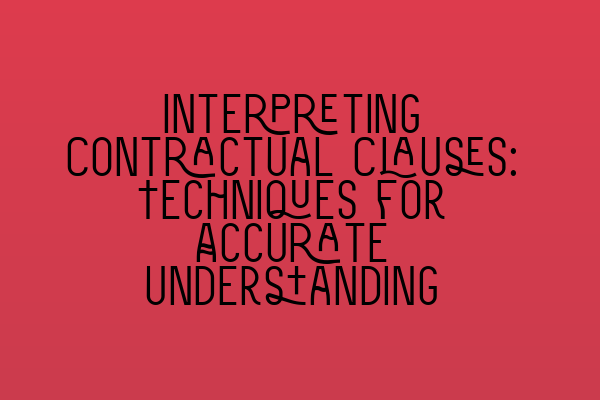
In the realm of contract law, interpreting contractual clauses is a fundamental task that solicitors and legal professionals undertake. The accurate understanding of these clauses is crucial to ensure the smooth functioning of contractual relationships and to mitigate potential disputes.
When it comes to interpreting contractual clauses, there are several techniques that can be employed. In this blog post, we will explore these techniques and provide you with a comprehensive guide to understanding and applying them effectively. So, whether you are a seasoned solicitor, a law student, or someone interested in gaining a deeper understanding of contract law, this article is for you.
Before we delve into the techniques, it is essential to comprehend the significance of interpreting contractual clauses. Contractual clauses are the building blocks of any contract, outlining the rights, obligations, and responsibilities of the parties involved. They define the scope and limitations of the agreement, ensuring that both parties are aware of their respective duties.
One crucial technique for interpreting contractual clauses is examining the plain meaning of the words used. Contractual clauses are drafted with meticulous attention to detail and precision. Therefore, it is essential to analyze the ordinary meaning of the words used in the clause. This involves considering the dictionary definitions, industry jargon, and any established legal interpretations of these words.
However, relying solely on the plain meaning of the words may not always provide a comprehensive understanding of the clause. Contracts often contain technical and specialized language specific to the industry or subject matter. In such cases, it becomes necessary to delve deeper into the context, purpose, and intention of the clause.
To understand the intent behind a contractual clause, it is crucial to consider the surrounding provisions of the contract. This technique, known as the “Ejusdem Generis” rule, involves interpreting ambiguous terms in light of the general context and purpose of the contract as a whole. By examining the related clauses, you can discern the intended meaning and ensure consistency throughout the agreement.
Furthermore, when interpreting contractual clauses, it is essential to consider any factual matrix or background knowledge that may aid in understanding the clause. This includes examining the circumstances surrounding the contract’s formation, the parties’ prior dealings, and any industry customs or practices. By gaining insight into the underlying context, you can accurately interpret the clause and uncover any hidden meanings.
In some cases, contractual clauses may incorporate by reference other documents or standard terms. These external documents can significantly impact the interpretation of the clause. Therefore, it is crucial to review and analyze the referenced materials to fully grasp the intended meaning and effect of the clause. Failure to consider these external documents may lead to a misinterpretation of the contractual clause.
To ensure a comprehensive understanding of contractual clauses, it is advisable to rely on legal precedents and case law. By referencing previous court decisions and established legal principles, you can navigate complex legal issues and gain valuable insights into the interpretation of contractual clauses. Legal precedents serve as guiding principles, providing clarity and consistency in the interpretation of contractual provisions.
In conclusion, interpreting contractual clauses is a delicate and nuanced task that requires careful consideration. By employing techniques such as analyzing the plain meaning of words, examining the surrounding provisions, considering the factual matrix and background knowledge, reviewing external documents, and referencing legal precedents, you can achieve an accurate understanding of these clauses.
Remember, accurate interpretation is the key to ensuring a fair and mutually beneficial contractual relationship. So, whether you are drafting a contract, negotiating its terms, or resolving a dispute, applying these techniques will enable you to navigate the complexities of contractual clauses effectively.
For further insights into interpreting contractual clauses and related topics, we recommend reading the following articles:
– Interpreting Contractual Clauses: Unlocking the Hidden Meanings
– Agreements in Contract Law: Understanding Its Various Types
– Essentials of Consideration: Understanding the Basis of Contractual Exchange
– Contract Law Tutorials: Simplifying Complex Concepts for Students
– Discharge of Contracts: Modes and Consequences Explained
By expanding your knowledge in these areas, you will gain a comprehensive understanding of contract law and enhance your legal expertise.
